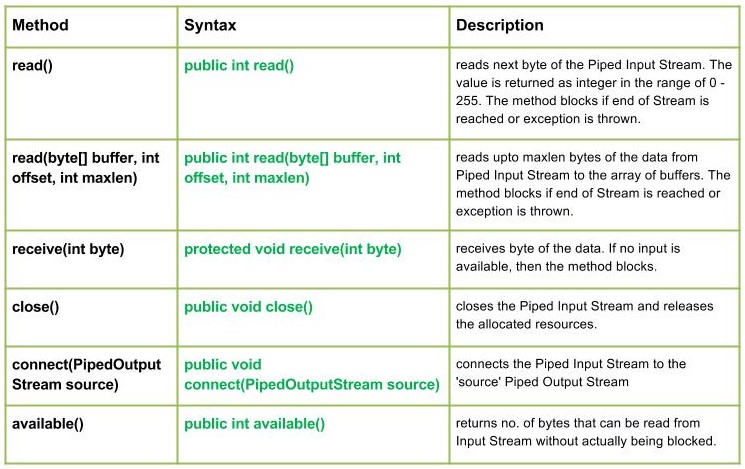IO 中的管道提供了 JVM 中同时运行的两个线程之间的链接。因此,管道既可以用作源也可以用作目标。
- PipedInputStream 也通过 PipedOutputStream 进行管道传输。因此,可以使用 PipedOutputStream 写入数据,也可以使用 PipedInputStream 写入数据。但是,同时使用两个线程将会导致线程死锁。
- 如果向连接的管道输出流提供数据字节的线程不再活动,则称管道已损坏。
声明:
public class PipedInputStream extends InputStream
构造函数:
- PipedInputStream():创建一个 PipedInputStream,它未连接。
- 管道输入流(int pSize):创建一个 PipedInputStream,它不与指定的管道大小连接。
- 管道输入流(管道输出流outStream):创建一个 PipedInputStream,它连接到 PipedOutputStream - ‘outStream’。
- PipedInputStream(PipedOutputStream outStream, int pSize):创建一个连接到具有指定管道大小的管道输出流的管道输入流。
方法:
- int read():从此管道输入流中读取数据的下一个字节。值字节以 0 到 255 范围内的 int 形式返回。此方法将阻塞,直到输入数据可用、检测到流的末尾或出现异常。抛出。
// Java program illustrating the working of read() method import java.io.*; public class NewClass { public static void main(String[] args) throws IOException { PipedInputStream geek_input = new PipedInputStream(); PipedOutputStream geek_output = new PipedOutputStream(); try { // Use of connect() : connecting geek_input with geek_output geek_input.connect(geek_output); // Use of read() method : geek_output.write(71); System.out.println("using read() : " + (char)geek_input.read()); geek_output.write(69); System.out.println("using read() : " + (char)geek_input.read()); geek_output.write(75); System.out.println("using read() : " + (char)geek_input.read()); } catch (IOException except) { except.printStackTrace(); } } }输出:
using read() : G using read() : E using read() : K
- 读取(字节[]缓冲区,int偏移量,int maxlen):java.io.PipedInputStream.read(byte[] 缓冲区, int 偏移量, int maxlen)将最多 maxlen 个字节的数据从管道输入流读取到缓冲区数组。如果到达 Stream 末尾或引发异常,该方法将阻塞。
Syntax :public int read(byte[] buffer, int offset, int maxlen) Parameters : buffer : the destination buffer into which the data is to be read offset : starting in the destination array - 'buffer'. maxlen : maximum length of array to be read Return : next 'maxlen' bytes of the data as an integer value return -1 is end of stream is reached Exception : -> IOException : if in case IO error occurs. -> NullPointerException : if buffer is null. -> IndexOutOfBoundsException : if offset is -ve or maxlen is -ve or maxlen > buffer.length - offset. - 接收(整数字节):java.io.PipedInputStream.receive(int byte)接收数据字节。如果没有可用的输入,则该方法会阻塞。
Syntax :protected void receive(int byte) Parameters : byte : the bytes of the data received Return : void Exception : -> IOException : if in case IO error occurs or pipe is broken.
- close():java.io.PipedInputStream.close()关闭管道输入流并释放分配的资源。
Syntax :public void close() Parameters : -------------- Return : void Exception : -> IOException : if in case IO error occurs.
- 连接(PipedOutputStream 源):java.io.PipedInputStream.connect(PipedOutputStream源)将管道输入流连接到 ‘source’ 管道输出流,如果 ‘source’ 是带有其他流的管道,则会引发 IO 异常
Syntax :public void connect(PipedOutputStream source) Parameters : source : the Piped Output Stream to be connected to Return : void Exception : -> IOException : if in case IO error occurs.
- available():java.io.PipedInputStream.available()返回编号可以从输入流读取而不会实际被阻塞的字节数。
Syntax :public int available() Parameters : ------------- Return : no. of bytes that can be read from Input Stream without actually being blocked. 0, if the stream is already closed but by invoking close() method Exception : -> IOException : if in case IO error occurs.
Java 程序解释PipedInputStream 类方法的用法原理:
// Java program illustrating the working of PipedInputStream
// connect(), read(byte[] buffer, int offset, int maxlen),
// close(), available()
import java.io.*;
public class NewClass
{
public static void main(String[] args) throws IOException
{
PipedInputStream geek_input = new PipedInputStream();
PipedOutputStream geek_output = new PipedOutputStream();
try
{
// Use of connect() : connecting geek_input with geek_output
geek_input.connect(geek_output);
geek_output.write(71);
geek_output.write(69);
geek_output.write(69);
geek_output.write(75);
geek_output.write(83);
// Use of available() :
System.out.println("Use of available() : " + geek_input.available());
// Use of read(byte[] buffer, int offset, int maxlen) :
byte[] buffer = new byte[5];
// destination 'buffer'
geek_input.read(buffer, 0, 5);
String str = new String(buffer);
System.out.println("Using read(buffer, offset, maxlen) : " + str);
// USe of close() method :
System.out.println("Closing the stream");
geek_input.close();
}
catch (IOException except)
{
except.printStackTrace();
}
}
} 输出:
Use of available() : 5 Using read(buffer, offset, maxlen) : GEEKS Closing the stream
下一篇:Java.io.PipedOutputStream class in Java
相关用法
- Java Java.io.PipedInputStream.available()用法及代码示例
- Java Java.io.PipedInputStream.close()用法及代码示例
- Java Java.io.PipedInputStream.connect()用法及代码示例
- Java Java.io.PipedInputStream.read()用法及代码示例
- Java Java.io.PipedOutputStream.close()用法及代码示例
- Java Java.io.PipedOutputStream.connect()用法及代码示例
- Java Java.io.PipedOutputStream.flush()用法及代码示例
- Java Java.io.PipedOutputStream.write()用法及代码示例
- Java Java.io.PipedReader.close()用法及代码示例
- Java Java.io.PipedReader.connect()用法及代码示例
- Java Java.io.PipedReader.read()用法及代码示例
- Java Java.io.PipedReader.ready()用法及代码示例
- Java Java.io.PipedWriter.close()用法及代码示例
- Java Java.io.PipedWriter.connect()用法及代码示例
- Java Java.io.PipedWriter.flush()用法及代码示例
- Java Java.io.PipedWriter.write()用法及代码示例
- Java Java.io.PipedReader用法及代码示例
- Java Java.io.PipedWriter用法及代码示例
- Java Java.io.PipedOutputStream用法及代码示例
- Java Java.io.PrintStream.append()用法及代码示例
- Java Java.io.PrintStream.checkError()用法及代码示例
- Java Java.io.PrintStream.clearError()用法及代码示例
- Java Java.io.PrintStream.close()用法及代码示例
- Java Java.io.PrintStream.flush()用法及代码示例
- Java Java.io.PrintStream.format()用法及代码示例
注:本文由纯净天空筛选整理自佚名大神的英文原创作品 Java.io.PipedInputStream class in Java。非经特殊声明,原始代码版权归原作者所有,本译文未经允许或授权,请勿转载或复制。

